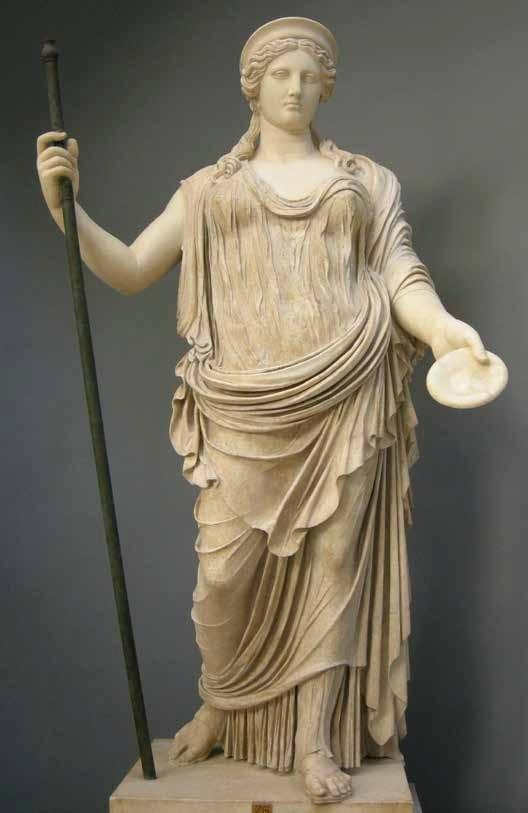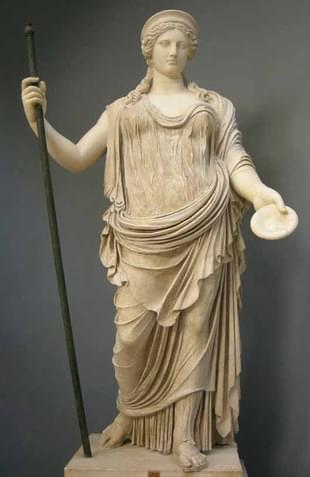Magazine
Hera’s Exiled Daughters
Mallika Nawal
May 08, 2015, 11:00 PM | Updated Feb 11, 2016, 09:27 AM IST
Save & read from anywhere!
Bookmark stories for easy access on any device or the Swarajya app.


On May 28, the second Menstrual Hygiene Day, let us vow to remove the stigma around menstruation so that all women can come out of their “menstrual exile” and lead a dignified and disease-free life.
I know that I am mortal by nature, and ephemeral; but when I trace at my pleasure the windings to and fro of the heavenly bodies, I no longer touch the earth with my feet. I stand in the presence of Zeus himself and take my fill of ambrosia, the food of the gods.
— Ptolemy (100-172 CE)
These words penned by one of antiquity’s greatest astronomers capture the ultimate longing of man…to “quench” his burning thirst— to drink from the cups of the Gods…to achieve everlasting youth and eternal immortality. And so the ephemeral man searched—in vain!—for the elusive ambrosia (or amrit).
According to Greek mythology, ambrosia was the “supernatural red wine” given to the gods by the great mother Hera through her daughter Hebe. The fair-haired Hebe, the goddess of youth and the daughter of Zeus and Hera, was the cupbearer for the gods and goddesses residing on Mount Olympus, serving them drinks of immortality.
Since then, man too has been keen to take a sip (or maybe a mouthful) from the fountain of youth. Considering the fact that it was Hebe who was the goddess of youth, and is eternally young, we can safely contend that man has been looking for ambrosia all of his natural life.
But if man has been looking for this magic liquid ever since, why then has he failed? Or has he?
The truth is… ancient man knew the truth. He was the pagan who worshipped the moon. He was the pagan who worshipped Mother Earth. He was the pagan who worshipped the Sacred Feminine.
In fact, the evidence has always been around us, hiding in mythical stories and ancient texts. The secret, in fact, lies with Hera, the goddess of all women. In her hand, she bears a simple fruit, the pomegranate—the emblem of fertile blood. Yes, the elixir of life lies with Hera…lies with all her daughters…lies with all women. The elixir of life is in fact menstrual blood, also referred to as “wine”, “mead” and “wise blood”.
The power of menstrual blood has been well-documented. For example, the Norse God Thor achieved immortality and enlightenment (after all, it’s “wise blood”) after bathing in a river of menstrual blood, known as Vimur. Similarly, in Taoism, the red yin juice was believed to give the drinker immortality. And that’s why the ancient pharaohs of Egypt sought to achieve divinity by drinking the blood of Isis.
The menstrual blood in the ancient world was viewed with reverence (unlike the disgust it generates today). It was seen as magical, healing and regenerating; and was connected with fertility and immortality. Its healing power has been well-documented by Roman author Pliny the Elder (23-79 CE) in his book Natural History. According to Pliny, menstrual blood was recommended as a cure for malaria and for many types of sores. What’s more, he claimed that it even had the power to cure leprosy.
One of course wonders then, if the powers of menstrual blood had been known and accepted, when did it achieve its present-day abomination?
Before we move to the answer, imagine a world where man did not know the role he played in the reproduction cycle. He simply bore witness to the divine power of a woman to create life (by herself “out of nothing” as it would have seemed to him). She had the power to play God. To him, childbirth would have been nothing short of a miracle. It is no wonder then that the ancient religions were matriarchal and worshipped the Sacred Feminine and her menstrual blood.
In fact, the evidence of this ancient reverence can be traced in the etymology of the word “menstruation”, which comes from the Greek word “menus”— meaning both “moon” and “power”. In fact, there’s a magical connection between the menstrual cycle and the lunar cycle (they both last 29.5 days). As such, menstruation is the only human event that corresponds to the lunar calendar.
Furthermore, according to anthropologists, the menstrual cycle may have been used once upon a time as a way to measure time. In addition, according to the leading American feminist Barbara Walker, the elixir of life in the Vedas, “soma”, in Persia “haoma”, in Egypt “sa”, were always associated with the moon and the maternal “blood of life”.
However, this “Matriarchal Paganism” was violently dethroned by the “Patriarchal Christianity” under the auspices of the pagan-turned-Christian Roman Emperor, Constantine (272-337 CE). With it came the fall of man! And surprise, surprise—it was the woman, Eve, who was responsible for this disgrace. In fact, the symbolism inherent in the “fall of man” further corroborates the fall of the Sacred Feminine and her menstrual powers. According to the Genesis, it was a crafty serpent that enticed Eve into taking a bite of the fruit (a red apple, nothing less) from the tree of knowledge.
Here’s the inherent symbolism in the story. Let’s take the serpent first. Medusa, the serpent-haired Gorgon in Greek mythology, is often seen as a menstrual emblem. Her petrifying gaze—like the gaze of a menstruating woman in various folklores—could turn a man to stone. In fact, according to the myth, Athene gave the healer Asclepius two phials of Medusa’s blood. With the blood that had been drawn from Medusa’s left side, he could raise the dead; while with the blood that had been drawn from the right side, he could destroy the mortal man. Furthermore, Medusa’s serpent-hair symbolizes menstrual secrets (which must always remain secret).
The second symbolism is the fruit itself—the “red” apple (or the “blood apple” that is regarded as the medium of menstrual blood). This symbolism (that is, the dire consequences of eating the forbidden fruit or consuming the menstrual blood) is also found in the fairy tale Snow White, where the sweet princess dies after one bite of the “poisonous” apple.
Last but not the least—the symbolism of the “Tree of Knowledge” itself. As mentioned earlier, menstrual blood was often referred to as “wise blood”. Bathing in it or consuming it was supposed to grant a person esoteric wisdom. It is little wonder then that patriarchal Christianity forbade its followers from taking a bite from the tree of knowledge. And thus, the elixir of life was lost.
According to German-American psychoanalyst Karen Horney, the association of menstruation with fertility and women’s ability to give life were envied by men and dreaded by them because it made women powerful. Taboos and rituals were a necessary invention of patriarchal cultures, therefore, in order to control women’s power. In the words of British academic Anne Walker, therefore, “menstrual envy” could be as powerful a reason for controlling women as menstrual disgust.
Thus, what was once an elixir became a curse! In patriarchies, men have traditionally feared menstrual blood, which was associated with uncleanliness and evil. Contact with menstrual blood, or even being in the presence of a menstruating woman was considered dangerous, even fatal. In the first century CE, Romans believed that the touch of a menstruating woman could blunt knives, sour wine, rust iron and cloud mirrors.

So scared was the Church that the original “Feminine” Holy Trinity (the Maiden, the Mother, and the Crone) was removed and replaced by the “Masculine” Holy Trinity (the Father, the Son, and the Holy Ghost). The Hagia Sophia in Istanbul—the sacred shrine to Sophia— lost its place amongst the Seven Wonders of the World. This “menstrual envy” was evident even when the Lord offered the chalice to his disciples and asked them to drink his blood “instead”.
The consumption of menstrual blood became a punishable offence, which is evident from the persecution of “alleged” witches during the Inquisition. In fact, according to evidence found amongst the Inquisition documents, some women were accused of witchcraft because they had mixed their menstrual blood in their husband’s food in order to keep them in love (Note: In witchcraft, menstrual blood is often seen as a powerful love potion).

Penelope Shuttle and Peter Redgrove described this extreme example of repression in their book, The Wise Wound: Menstruation and Everywoman, which resulted in the persecution and killing of witches by the patriarchal Church, often described as “nine million menstrual murders”.
In short, the “fall of man” in Christian theology was actually the “fall of woman”. Since then, menstruation has become a taboo topic. This explains why a key component of menstrual etiquette is concealment. This “stigma” is evident in advertising too, where a “blue” liquid (instead of “red”) is poured into the sanitary product to demonstrate its “absorbtiveness”. Of course, this is nothing new. After all, in 1928, Johnson & Johnson developed a coupon that women could use to buy sanitary products without ever “mentioning” the word “menstruation”.
According to Jyoti Sanghera, Chief of the UN Human Rights Office, Economic and Social Issues Section, this “stigma around menstruation and menstrual hygiene is a violation of several human rights, most importantly of the right to human dignity”.
This stigma not only reduces a woman’s dignity, this veil of secrecy is the reason why India accounts for 27 per cent of the world’s cervical cancer deaths (Source: WHO). The incidence rate is twice the global average, and doctors studying the disease say poor menstrual hygiene is partly to blame. According to an A.C. Nielsen survey commissioned by the Indian government, only 12 per cent of the women in India use sanitary products. The rest rely on old fabrics, husks, dried leaves and grass, ash, sand, newspapers…even cow dung.
However, not all is lost. After a long and arduous journey, man has once again discovered the “healing powers” of the “supernatural red wine”. Inside our labs, menstrual stem cells—which come from the womb lining shed during a woman’s period—are being harvested, which could potentially be incorporated into treatments for stroke, Alzheimer’s disease, Lou Gehrig’s disease or even amyotrophic lateral sclerosis.
What’s more, menstrual stem cells come with the added advantage of a painless non-invasive procedure as compared to other stem cell sources such as bone marrow. As early lab work suggests, they can turn into many other types of cells, including heart, nerve, bone, cartilage and fat. Science has finally realized that a woman’s womb is neither a reproductive factory, nor is menstruation proof of failed production. Hence, on this May 28, as we celebrate the second Menstrual Hygiene Day, let us vow to remove the stigma around menstruation so that all women can come out of their “menstrual exile” and lead a dignified and disease-free life. Here’s to all the daughters of Hera—may you discover the power within!
[/level-subscriber]Mallika Nawal is a professor-cum-author, about to complete her doctorate in marketing from IIT Kharagpur. She is the author of three management books which serve as prescribed textbooks in several universities across India. She has taught at premier institutes like IIT Kharagpur, and S. P. Jain Centre of Management, Dubai.





